Taxation Law Case Study: Applying ITAA and Providing Client Advice
VerifiedAdded on 2022/12/23
|12
|2811
|73
Case Study
AI Summary
This case study delves into various aspects of Australian taxation law, addressing questions related to constitutional powers, the roles of the government and the ATO, and the tax implications of business profits and capital gains. It analyzes scenarios involving property sales, post-cessation expenditure, and the application of Capital Gains Tax (CGT) rules. The assignment also examines two articles from the Australian Financial Review concerning ATO measures on home office expenses and the removal of refundable franking credits, linking these concepts to good tax policy. Furthermore, the case study explores the legal principles and precedents relevant to each scenario, offering detailed explanations and providing recommendations to the client based on the interpretation of relevant legislation and case law. The document provides a comprehensive analysis of the tax implications for various business and personal financial situations, including capital gains and losses.
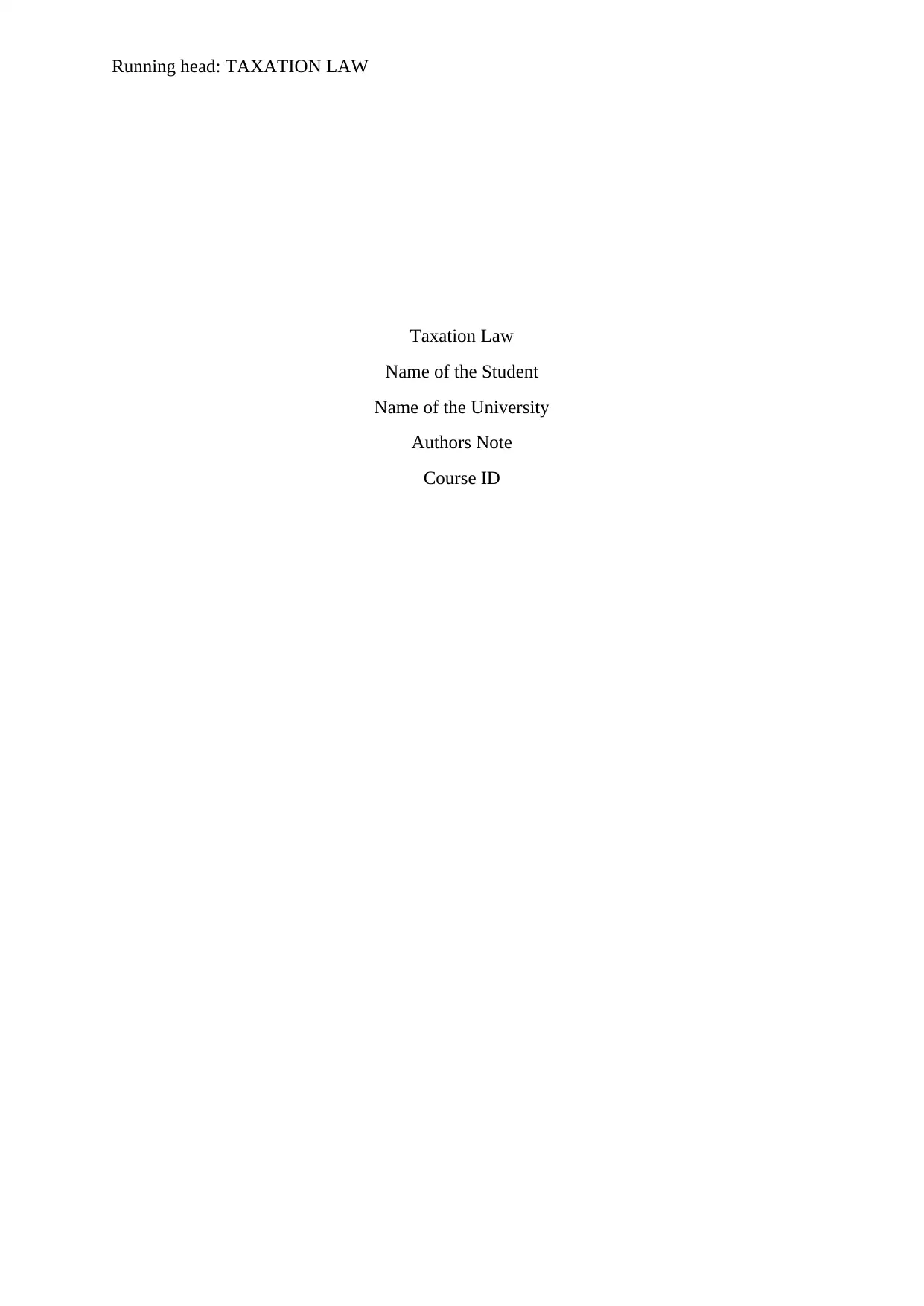
Running head: TAXATION LAW
Taxation Law
Name of the Student
Name of the University
Authors Note
Course ID
Taxation Law
Name of the Student
Name of the University
Authors Note
Course ID
Paraphrase This Document
Need a fresh take? Get an instant paraphrase of this document with our AI Paraphraser
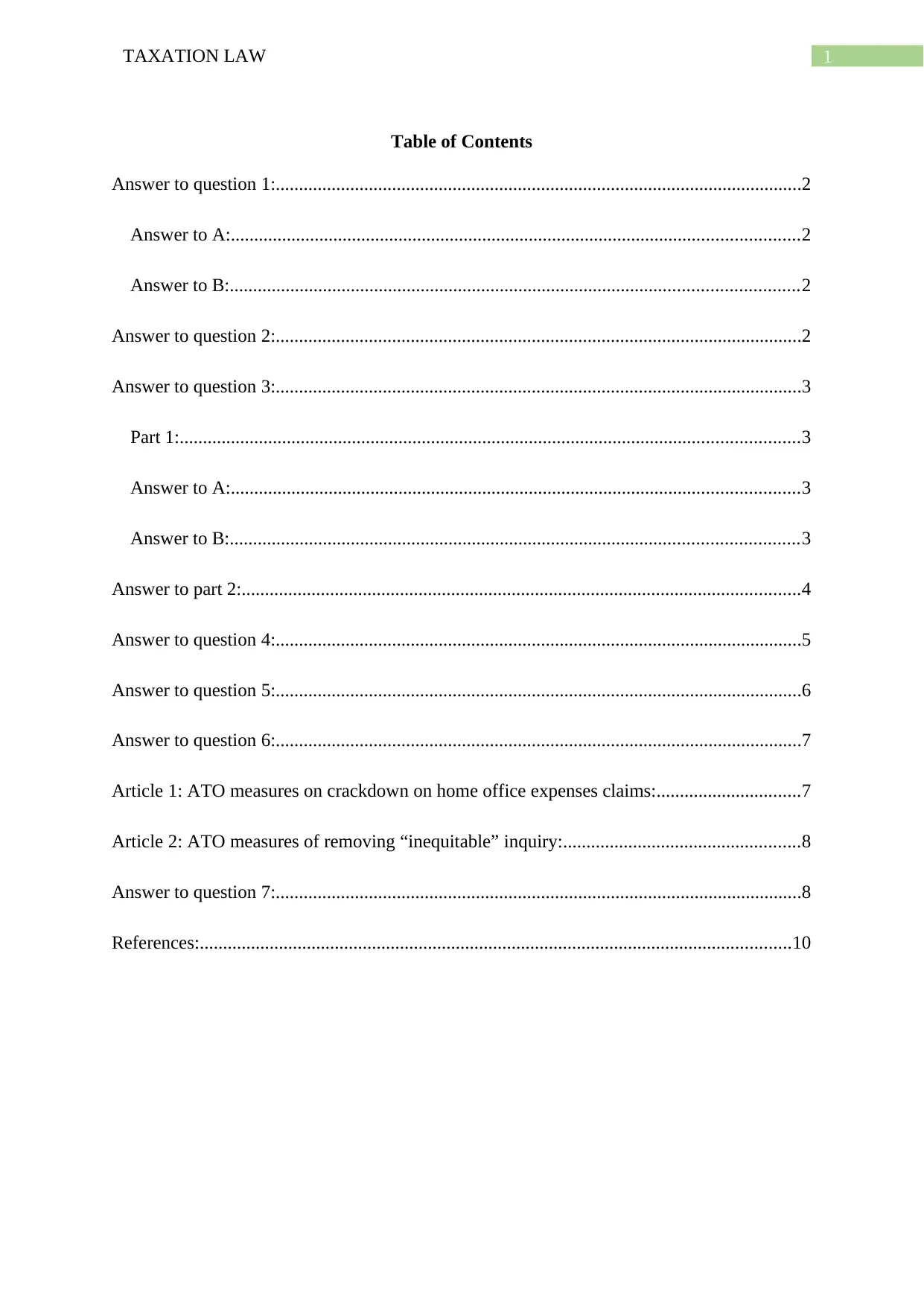
1TAXATION LAW
Table of Contents
Answer to question 1:.................................................................................................................2
Answer to A:..........................................................................................................................2
Answer to B:..........................................................................................................................2
Answer to question 2:.................................................................................................................2
Answer to question 3:.................................................................................................................3
Part 1:.....................................................................................................................................3
Answer to A:..........................................................................................................................3
Answer to B:..........................................................................................................................3
Answer to part 2:........................................................................................................................4
Answer to question 4:.................................................................................................................5
Answer to question 5:.................................................................................................................6
Answer to question 6:.................................................................................................................7
Article 1: ATO measures on crackdown on home office expenses claims:...............................7
Article 2: ATO measures of removing “inequitable” inquiry:...................................................8
Answer to question 7:.................................................................................................................8
References:...............................................................................................................................10
Table of Contents
Answer to question 1:.................................................................................................................2
Answer to A:..........................................................................................................................2
Answer to B:..........................................................................................................................2
Answer to question 2:.................................................................................................................2
Answer to question 3:.................................................................................................................3
Part 1:.....................................................................................................................................3
Answer to A:..........................................................................................................................3
Answer to B:..........................................................................................................................3
Answer to part 2:........................................................................................................................4
Answer to question 4:.................................................................................................................5
Answer to question 5:.................................................................................................................6
Answer to question 6:.................................................................................................................7
Article 1: ATO measures on crackdown on home office expenses claims:...............................7
Article 2: ATO measures of removing “inequitable” inquiry:...................................................8
Answer to question 7:.................................................................................................................8
References:...............................................................................................................................10
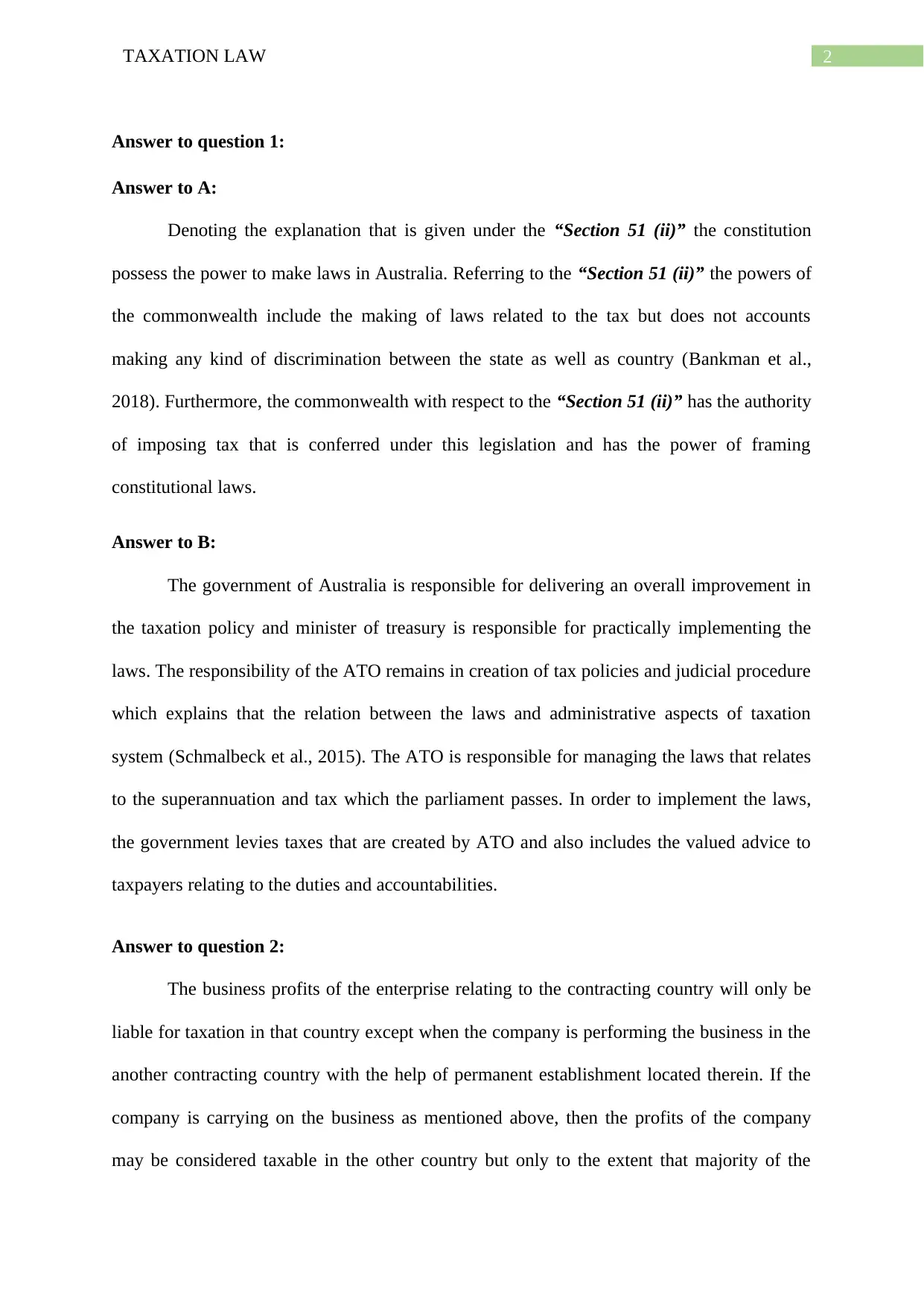
2TAXATION LAW
Answer to question 1:
Answer to A:
Denoting the explanation that is given under the “Section 51 (ii)” the constitution
possess the power to make laws in Australia. Referring to the “Section 51 (ii)” the powers of
the commonwealth include the making of laws related to the tax but does not accounts
making any kind of discrimination between the state as well as country (Bankman et al.,
2018). Furthermore, the commonwealth with respect to the “Section 51 (ii)” has the authority
of imposing tax that is conferred under this legislation and has the power of framing
constitutional laws.
Answer to B:
The government of Australia is responsible for delivering an overall improvement in
the taxation policy and minister of treasury is responsible for practically implementing the
laws. The responsibility of the ATO remains in creation of tax policies and judicial procedure
which explains that the relation between the laws and administrative aspects of taxation
system (Schmalbeck et al., 2015). The ATO is responsible for managing the laws that relates
to the superannuation and tax which the parliament passes. In order to implement the laws,
the government levies taxes that are created by ATO and also includes the valued advice to
taxpayers relating to the duties and accountabilities.
Answer to question 2:
The business profits of the enterprise relating to the contracting country will only be
liable for taxation in that country except when the company is performing the business in the
another contracting country with the help of permanent establishment located therein. If the
company is carrying on the business as mentioned above, then the profits of the company
may be considered taxable in the other country but only to the extent that majority of the
Answer to question 1:
Answer to A:
Denoting the explanation that is given under the “Section 51 (ii)” the constitution
possess the power to make laws in Australia. Referring to the “Section 51 (ii)” the powers of
the commonwealth include the making of laws related to the tax but does not accounts
making any kind of discrimination between the state as well as country (Bankman et al.,
2018). Furthermore, the commonwealth with respect to the “Section 51 (ii)” has the authority
of imposing tax that is conferred under this legislation and has the power of framing
constitutional laws.
Answer to B:
The government of Australia is responsible for delivering an overall improvement in
the taxation policy and minister of treasury is responsible for practically implementing the
laws. The responsibility of the ATO remains in creation of tax policies and judicial procedure
which explains that the relation between the laws and administrative aspects of taxation
system (Schmalbeck et al., 2015). The ATO is responsible for managing the laws that relates
to the superannuation and tax which the parliament passes. In order to implement the laws,
the government levies taxes that are created by ATO and also includes the valued advice to
taxpayers relating to the duties and accountabilities.
Answer to question 2:
The business profits of the enterprise relating to the contracting country will only be
liable for taxation in that country except when the company is performing the business in the
another contracting country with the help of permanent establishment located therein. If the
company is carrying on the business as mentioned above, then the profits of the company
may be considered taxable in the other country but only to the extent that majority of the
⊘ This is a preview!⊘
Do you want full access?
Subscribe today to unlock all pages.

Trusted by 1+ million students worldwide
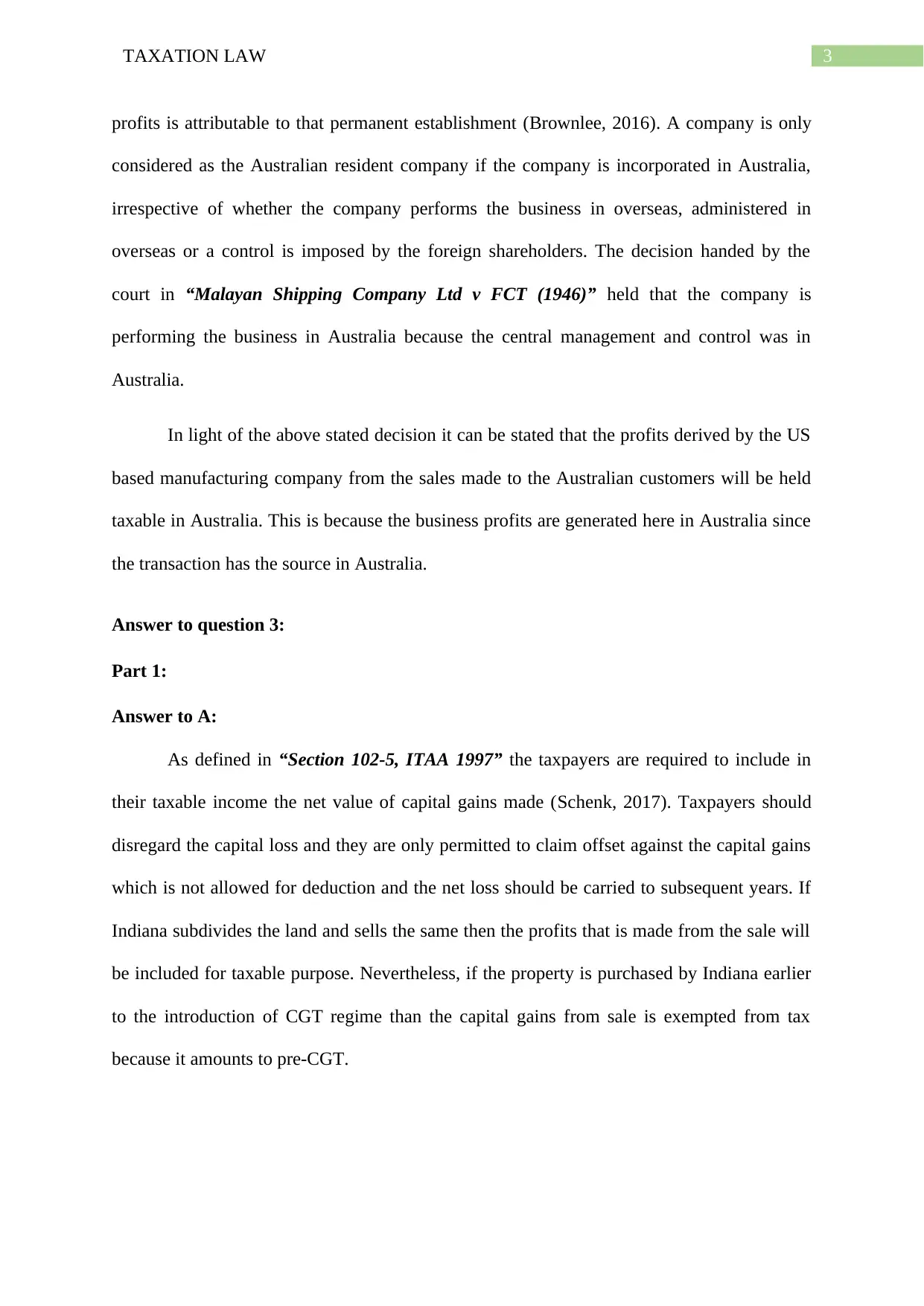
3TAXATION LAW
profits is attributable to that permanent establishment (Brownlee, 2016). A company is only
considered as the Australian resident company if the company is incorporated in Australia,
irrespective of whether the company performs the business in overseas, administered in
overseas or a control is imposed by the foreign shareholders. The decision handed by the
court in “Malayan Shipping Company Ltd v FCT (1946)” held that the company is
performing the business in Australia because the central management and control was in
Australia.
In light of the above stated decision it can be stated that the profits derived by the US
based manufacturing company from the sales made to the Australian customers will be held
taxable in Australia. This is because the business profits are generated here in Australia since
the transaction has the source in Australia.
Answer to question 3:
Part 1:
Answer to A:
As defined in “Section 102-5, ITAA 1997” the taxpayers are required to include in
their taxable income the net value of capital gains made (Schenk, 2017). Taxpayers should
disregard the capital loss and they are only permitted to claim offset against the capital gains
which is not allowed for deduction and the net loss should be carried to subsequent years. If
Indiana subdivides the land and sells the same then the profits that is made from the sale will
be included for taxable purpose. Nevertheless, if the property is purchased by Indiana earlier
to the introduction of CGT regime than the capital gains from sale is exempted from tax
because it amounts to pre-CGT.
profits is attributable to that permanent establishment (Brownlee, 2016). A company is only
considered as the Australian resident company if the company is incorporated in Australia,
irrespective of whether the company performs the business in overseas, administered in
overseas or a control is imposed by the foreign shareholders. The decision handed by the
court in “Malayan Shipping Company Ltd v FCT (1946)” held that the company is
performing the business in Australia because the central management and control was in
Australia.
In light of the above stated decision it can be stated that the profits derived by the US
based manufacturing company from the sales made to the Australian customers will be held
taxable in Australia. This is because the business profits are generated here in Australia since
the transaction has the source in Australia.
Answer to question 3:
Part 1:
Answer to A:
As defined in “Section 102-5, ITAA 1997” the taxpayers are required to include in
their taxable income the net value of capital gains made (Schenk, 2017). Taxpayers should
disregard the capital loss and they are only permitted to claim offset against the capital gains
which is not allowed for deduction and the net loss should be carried to subsequent years. If
Indiana subdivides the land and sells the same then the profits that is made from the sale will
be included for taxable purpose. Nevertheless, if the property is purchased by Indiana earlier
to the introduction of CGT regime than the capital gains from sale is exempted from tax
because it amounts to pre-CGT.
Paraphrase This Document
Need a fresh take? Get an instant paraphrase of this document with our AI Paraphraser
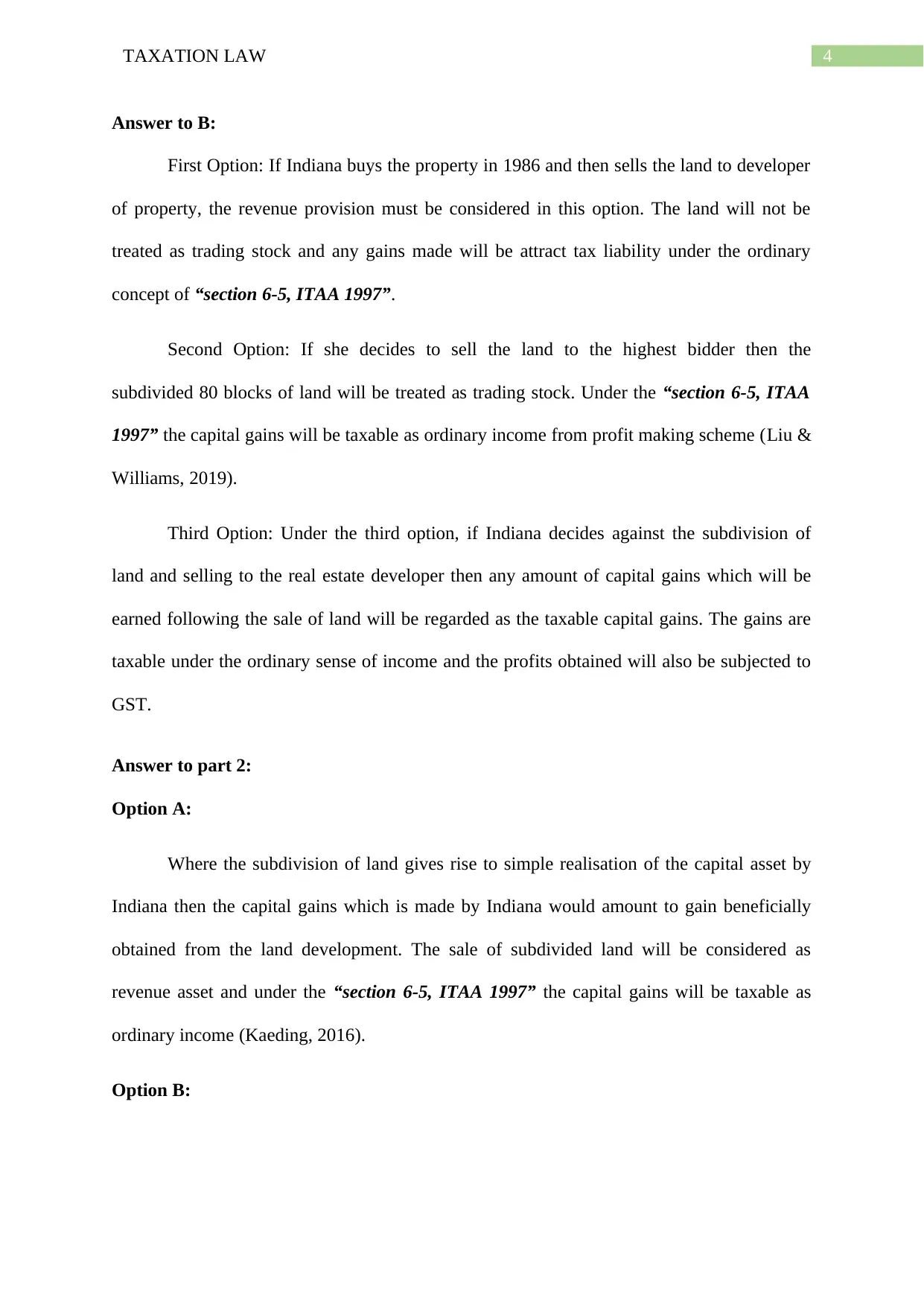
4TAXATION LAW
Answer to B:
First Option: If Indiana buys the property in 1986 and then sells the land to developer
of property, the revenue provision must be considered in this option. The land will not be
treated as trading stock and any gains made will be attract tax liability under the ordinary
concept of “section 6-5, ITAA 1997”.
Second Option: If she decides to sell the land to the highest bidder then the
subdivided 80 blocks of land will be treated as trading stock. Under the “section 6-5, ITAA
1997” the capital gains will be taxable as ordinary income from profit making scheme (Liu &
Williams, 2019).
Third Option: Under the third option, if Indiana decides against the subdivision of
land and selling to the real estate developer then any amount of capital gains which will be
earned following the sale of land will be regarded as the taxable capital gains. The gains are
taxable under the ordinary sense of income and the profits obtained will also be subjected to
GST.
Answer to part 2:
Option A:
Where the subdivision of land gives rise to simple realisation of the capital asset by
Indiana then the capital gains which is made by Indiana would amount to gain beneficially
obtained from the land development. The sale of subdivided land will be considered as
revenue asset and under the “section 6-5, ITAA 1997” the capital gains will be taxable as
ordinary income (Kaeding, 2016).
Option B:
Answer to B:
First Option: If Indiana buys the property in 1986 and then sells the land to developer
of property, the revenue provision must be considered in this option. The land will not be
treated as trading stock and any gains made will be attract tax liability under the ordinary
concept of “section 6-5, ITAA 1997”.
Second Option: If she decides to sell the land to the highest bidder then the
subdivided 80 blocks of land will be treated as trading stock. Under the “section 6-5, ITAA
1997” the capital gains will be taxable as ordinary income from profit making scheme (Liu &
Williams, 2019).
Third Option: Under the third option, if Indiana decides against the subdivision of
land and selling to the real estate developer then any amount of capital gains which will be
earned following the sale of land will be regarded as the taxable capital gains. The gains are
taxable under the ordinary sense of income and the profits obtained will also be subjected to
GST.
Answer to part 2:
Option A:
Where the subdivision of land gives rise to simple realisation of the capital asset by
Indiana then the capital gains which is made by Indiana would amount to gain beneficially
obtained from the land development. The sale of subdivided land will be considered as
revenue asset and under the “section 6-5, ITAA 1997” the capital gains will be taxable as
ordinary income (Kaeding, 2016).
Option B:
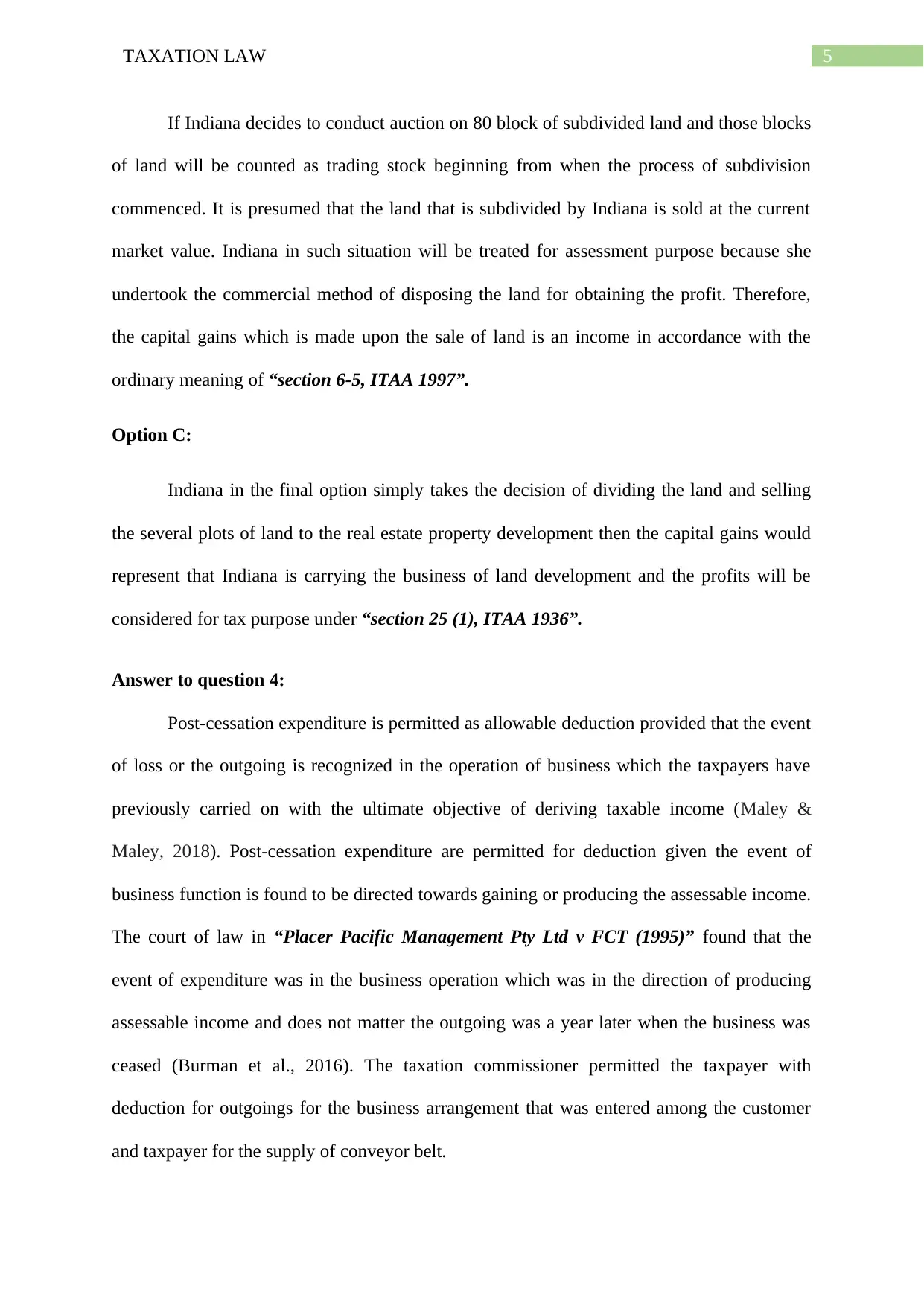
5TAXATION LAW
If Indiana decides to conduct auction on 80 block of subdivided land and those blocks
of land will be counted as trading stock beginning from when the process of subdivision
commenced. It is presumed that the land that is subdivided by Indiana is sold at the current
market value. Indiana in such situation will be treated for assessment purpose because she
undertook the commercial method of disposing the land for obtaining the profit. Therefore,
the capital gains which is made upon the sale of land is an income in accordance with the
ordinary meaning of “section 6-5, ITAA 1997”.
Option C:
Indiana in the final option simply takes the decision of dividing the land and selling
the several plots of land to the real estate property development then the capital gains would
represent that Indiana is carrying the business of land development and the profits will be
considered for tax purpose under “section 25 (1), ITAA 1936”.
Answer to question 4:
Post-cessation expenditure is permitted as allowable deduction provided that the event
of loss or the outgoing is recognized in the operation of business which the taxpayers have
previously carried on with the ultimate objective of deriving taxable income (Maley &
Maley, 2018). Post-cessation expenditure are permitted for deduction given the event of
business function is found to be directed towards gaining or producing the assessable income.
The court of law in “Placer Pacific Management Pty Ltd v FCT (1995)” found that the
event of expenditure was in the business operation which was in the direction of producing
assessable income and does not matter the outgoing was a year later when the business was
ceased (Burman et al., 2016). The taxation commissioner permitted the taxpayer with
deduction for outgoings for the business arrangement that was entered among the customer
and taxpayer for the supply of conveyor belt.
If Indiana decides to conduct auction on 80 block of subdivided land and those blocks
of land will be counted as trading stock beginning from when the process of subdivision
commenced. It is presumed that the land that is subdivided by Indiana is sold at the current
market value. Indiana in such situation will be treated for assessment purpose because she
undertook the commercial method of disposing the land for obtaining the profit. Therefore,
the capital gains which is made upon the sale of land is an income in accordance with the
ordinary meaning of “section 6-5, ITAA 1997”.
Option C:
Indiana in the final option simply takes the decision of dividing the land and selling
the several plots of land to the real estate property development then the capital gains would
represent that Indiana is carrying the business of land development and the profits will be
considered for tax purpose under “section 25 (1), ITAA 1936”.
Answer to question 4:
Post-cessation expenditure is permitted as allowable deduction provided that the event
of loss or the outgoing is recognized in the operation of business which the taxpayers have
previously carried on with the ultimate objective of deriving taxable income (Maley &
Maley, 2018). Post-cessation expenditure are permitted for deduction given the event of
business function is found to be directed towards gaining or producing the assessable income.
The court of law in “Placer Pacific Management Pty Ltd v FCT (1995)” found that the
event of expenditure was in the business operation which was in the direction of producing
assessable income and does not matter the outgoing was a year later when the business was
ceased (Burman et al., 2016). The taxation commissioner permitted the taxpayer with
deduction for outgoings for the business arrangement that was entered among the customer
and taxpayer for the supply of conveyor belt.
⊘ This is a preview!⊘
Do you want full access?
Subscribe today to unlock all pages.

Trusted by 1+ million students worldwide
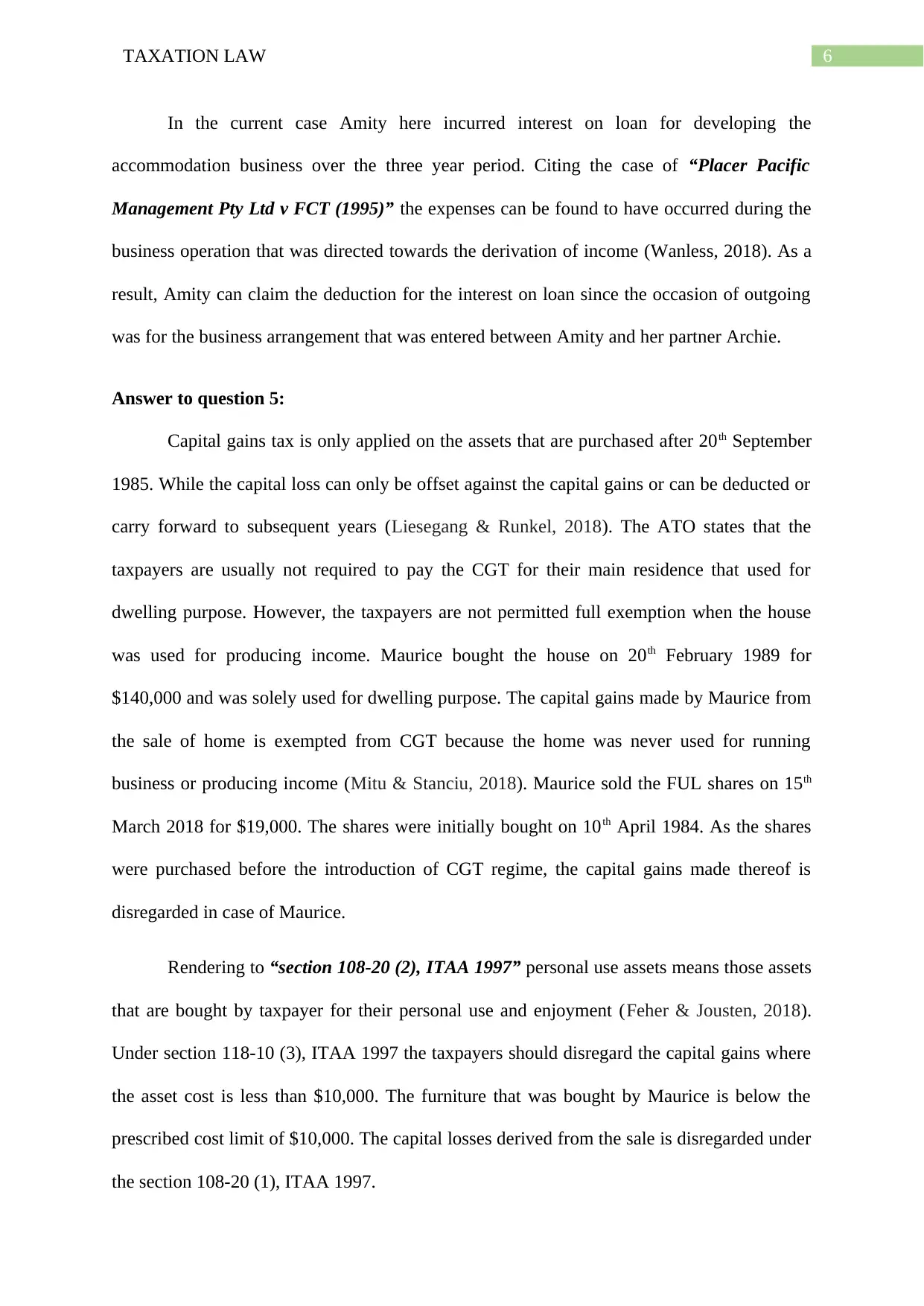
6TAXATION LAW
In the current case Amity here incurred interest on loan for developing the
accommodation business over the three year period. Citing the case of “Placer Pacific
Management Pty Ltd v FCT (1995)” the expenses can be found to have occurred during the
business operation that was directed towards the derivation of income (Wanless, 2018). As a
result, Amity can claim the deduction for the interest on loan since the occasion of outgoing
was for the business arrangement that was entered between Amity and her partner Archie.
Answer to question 5:
Capital gains tax is only applied on the assets that are purchased after 20th September
1985. While the capital loss can only be offset against the capital gains or can be deducted or
carry forward to subsequent years (Liesegang & Runkel, 2018). The ATO states that the
taxpayers are usually not required to pay the CGT for their main residence that used for
dwelling purpose. However, the taxpayers are not permitted full exemption when the house
was used for producing income. Maurice bought the house on 20th February 1989 for
$140,000 and was solely used for dwelling purpose. The capital gains made by Maurice from
the sale of home is exempted from CGT because the home was never used for running
business or producing income (Mitu & Stanciu, 2018). Maurice sold the FUL shares on 15th
March 2018 for $19,000. The shares were initially bought on 10th April 1984. As the shares
were purchased before the introduction of CGT regime, the capital gains made thereof is
disregarded in case of Maurice.
Rendering to “section 108-20 (2), ITAA 1997” personal use assets means those assets
that are bought by taxpayer for their personal use and enjoyment (Feher & Jousten, 2018).
Under section 118-10 (3), ITAA 1997 the taxpayers should disregard the capital gains where
the asset cost is less than $10,000. The furniture that was bought by Maurice is below the
prescribed cost limit of $10,000. The capital losses derived from the sale is disregarded under
the section 108-20 (1), ITAA 1997.
In the current case Amity here incurred interest on loan for developing the
accommodation business over the three year period. Citing the case of “Placer Pacific
Management Pty Ltd v FCT (1995)” the expenses can be found to have occurred during the
business operation that was directed towards the derivation of income (Wanless, 2018). As a
result, Amity can claim the deduction for the interest on loan since the occasion of outgoing
was for the business arrangement that was entered between Amity and her partner Archie.
Answer to question 5:
Capital gains tax is only applied on the assets that are purchased after 20th September
1985. While the capital loss can only be offset against the capital gains or can be deducted or
carry forward to subsequent years (Liesegang & Runkel, 2018). The ATO states that the
taxpayers are usually not required to pay the CGT for their main residence that used for
dwelling purpose. However, the taxpayers are not permitted full exemption when the house
was used for producing income. Maurice bought the house on 20th February 1989 for
$140,000 and was solely used for dwelling purpose. The capital gains made by Maurice from
the sale of home is exempted from CGT because the home was never used for running
business or producing income (Mitu & Stanciu, 2018). Maurice sold the FUL shares on 15th
March 2018 for $19,000. The shares were initially bought on 10th April 1984. As the shares
were purchased before the introduction of CGT regime, the capital gains made thereof is
disregarded in case of Maurice.
Rendering to “section 108-20 (2), ITAA 1997” personal use assets means those assets
that are bought by taxpayer for their personal use and enjoyment (Feher & Jousten, 2018).
Under section 118-10 (3), ITAA 1997 the taxpayers should disregard the capital gains where
the asset cost is less than $10,000. The furniture that was bought by Maurice is below the
prescribed cost limit of $10,000. The capital losses derived from the sale is disregarded under
the section 108-20 (1), ITAA 1997.
Paraphrase This Document
Need a fresh take? Get an instant paraphrase of this document with our AI Paraphraser
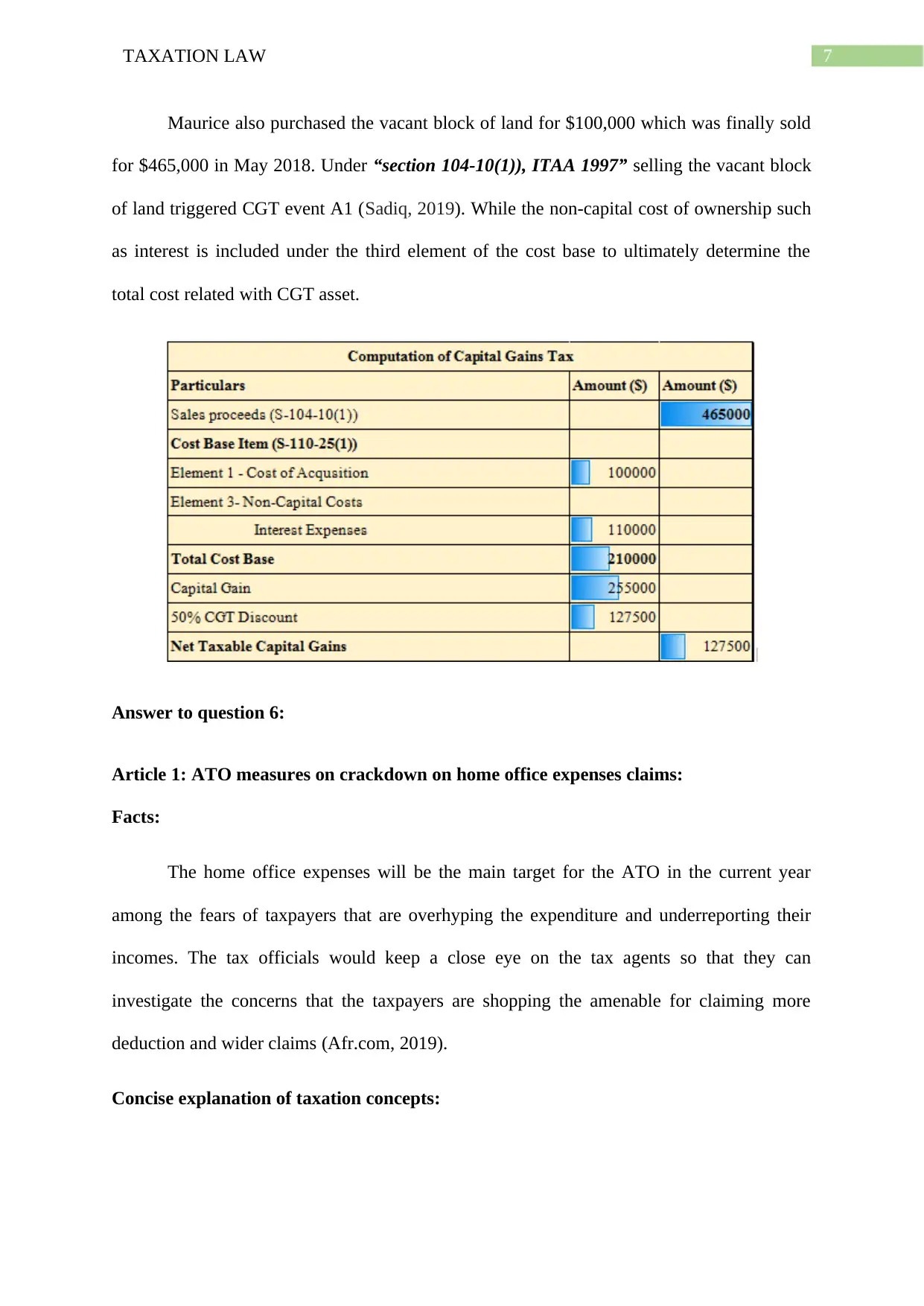
7TAXATION LAW
Maurice also purchased the vacant block of land for $100,000 which was finally sold
for $465,000 in May 2018. Under “section 104-10(1)), ITAA 1997” selling the vacant block
of land triggered CGT event A1 (Sadiq, 2019). While the non-capital cost of ownership such
as interest is included under the third element of the cost base to ultimately determine the
total cost related with CGT asset.
Answer to question 6:
Article 1: ATO measures on crackdown on home office expenses claims:
Facts:
The home office expenses will be the main target for the ATO in the current year
among the fears of taxpayers that are overhyping the expenditure and underreporting their
incomes. The tax officials would keep a close eye on the tax agents so that they can
investigate the concerns that the taxpayers are shopping the amenable for claiming more
deduction and wider claims (Afr.com, 2019).
Concise explanation of taxation concepts:
Maurice also purchased the vacant block of land for $100,000 which was finally sold
for $465,000 in May 2018. Under “section 104-10(1)), ITAA 1997” selling the vacant block
of land triggered CGT event A1 (Sadiq, 2019). While the non-capital cost of ownership such
as interest is included under the third element of the cost base to ultimately determine the
total cost related with CGT asset.
Answer to question 6:
Article 1: ATO measures on crackdown on home office expenses claims:
Facts:
The home office expenses will be the main target for the ATO in the current year
among the fears of taxpayers that are overhyping the expenditure and underreporting their
incomes. The tax officials would keep a close eye on the tax agents so that they can
investigate the concerns that the taxpayers are shopping the amenable for claiming more
deduction and wider claims (Afr.com, 2019).
Concise explanation of taxation concepts:
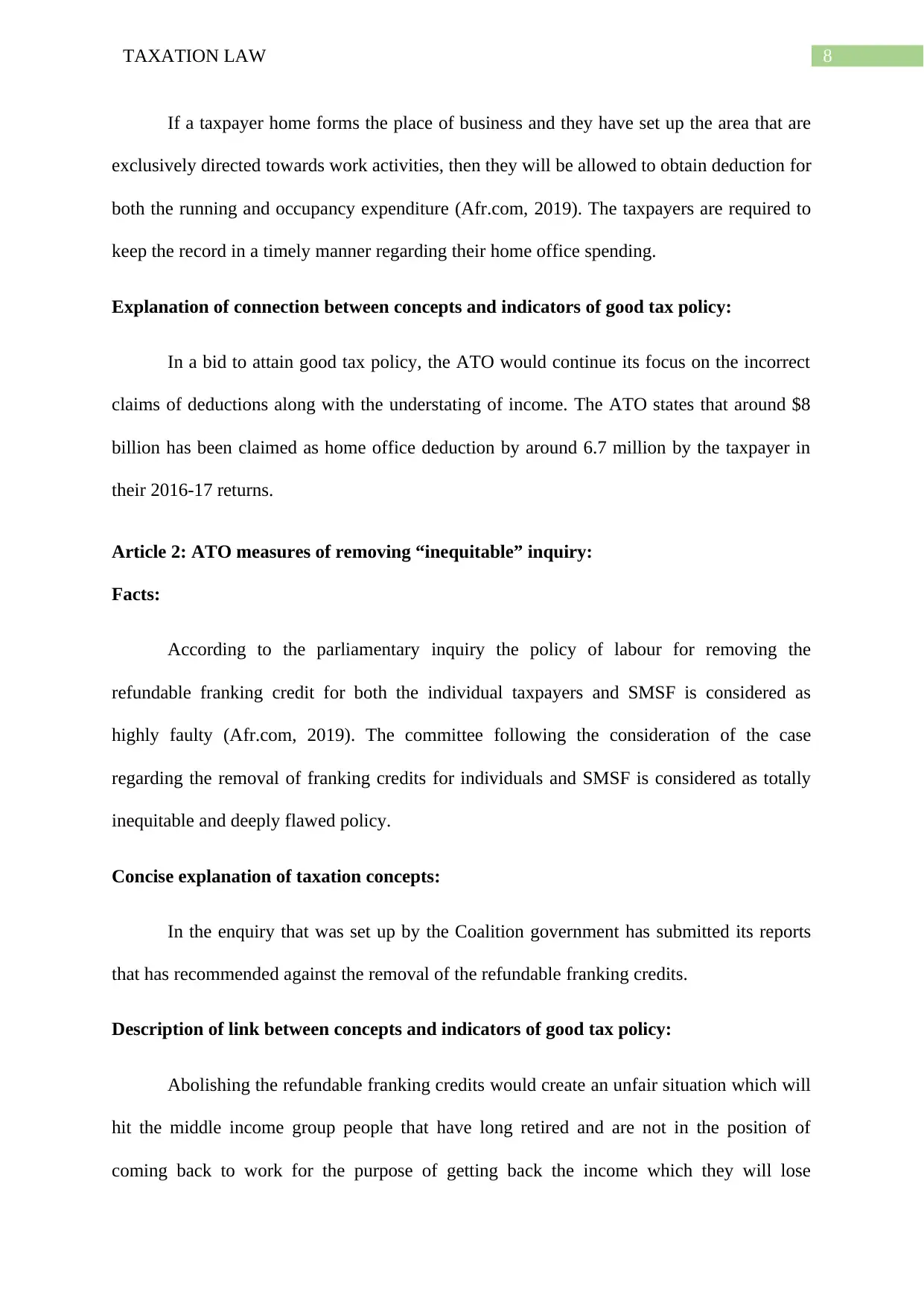
8TAXATION LAW
If a taxpayer home forms the place of business and they have set up the area that are
exclusively directed towards work activities, then they will be allowed to obtain deduction for
both the running and occupancy expenditure (Afr.com, 2019). The taxpayers are required to
keep the record in a timely manner regarding their home office spending.
Explanation of connection between concepts and indicators of good tax policy:
In a bid to attain good tax policy, the ATO would continue its focus on the incorrect
claims of deductions along with the understating of income. The ATO states that around $8
billion has been claimed as home office deduction by around 6.7 million by the taxpayer in
their 2016-17 returns.
Article 2: ATO measures of removing “inequitable” inquiry:
Facts:
According to the parliamentary inquiry the policy of labour for removing the
refundable franking credit for both the individual taxpayers and SMSF is considered as
highly faulty (Afr.com, 2019). The committee following the consideration of the case
regarding the removal of franking credits for individuals and SMSF is considered as totally
inequitable and deeply flawed policy.
Concise explanation of taxation concepts:
In the enquiry that was set up by the Coalition government has submitted its reports
that has recommended against the removal of the refundable franking credits.
Description of link between concepts and indicators of good tax policy:
Abolishing the refundable franking credits would create an unfair situation which will
hit the middle income group people that have long retired and are not in the position of
coming back to work for the purpose of getting back the income which they will lose
If a taxpayer home forms the place of business and they have set up the area that are
exclusively directed towards work activities, then they will be allowed to obtain deduction for
both the running and occupancy expenditure (Afr.com, 2019). The taxpayers are required to
keep the record in a timely manner regarding their home office spending.
Explanation of connection between concepts and indicators of good tax policy:
In a bid to attain good tax policy, the ATO would continue its focus on the incorrect
claims of deductions along with the understating of income. The ATO states that around $8
billion has been claimed as home office deduction by around 6.7 million by the taxpayer in
their 2016-17 returns.
Article 2: ATO measures of removing “inequitable” inquiry:
Facts:
According to the parliamentary inquiry the policy of labour for removing the
refundable franking credit for both the individual taxpayers and SMSF is considered as
highly faulty (Afr.com, 2019). The committee following the consideration of the case
regarding the removal of franking credits for individuals and SMSF is considered as totally
inequitable and deeply flawed policy.
Concise explanation of taxation concepts:
In the enquiry that was set up by the Coalition government has submitted its reports
that has recommended against the removal of the refundable franking credits.
Description of link between concepts and indicators of good tax policy:
Abolishing the refundable franking credits would create an unfair situation which will
hit the middle income group people that have long retired and are not in the position of
coming back to work for the purpose of getting back the income which they will lose
⊘ This is a preview!⊘
Do you want full access?
Subscribe today to unlock all pages.

Trusted by 1+ million students worldwide
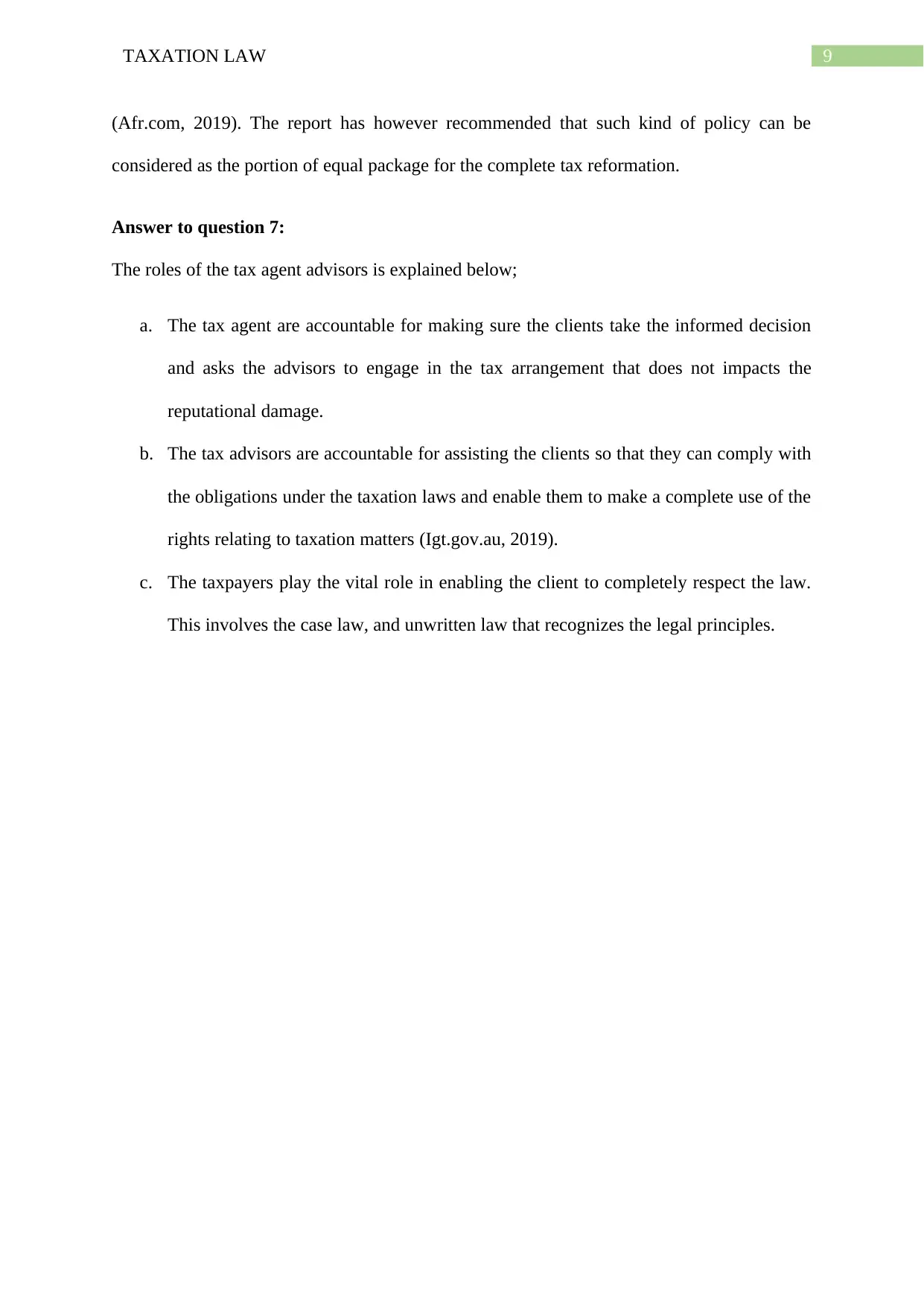
9TAXATION LAW
(Afr.com, 2019). The report has however recommended that such kind of policy can be
considered as the portion of equal package for the complete tax reformation.
Answer to question 7:
The roles of the tax agent advisors is explained below;
a. The tax agent are accountable for making sure the clients take the informed decision
and asks the advisors to engage in the tax arrangement that does not impacts the
reputational damage.
b. The tax advisors are accountable for assisting the clients so that they can comply with
the obligations under the taxation laws and enable them to make a complete use of the
rights relating to taxation matters (Igt.gov.au, 2019).
c. The taxpayers play the vital role in enabling the client to completely respect the law.
This involves the case law, and unwritten law that recognizes the legal principles.
(Afr.com, 2019). The report has however recommended that such kind of policy can be
considered as the portion of equal package for the complete tax reformation.
Answer to question 7:
The roles of the tax agent advisors is explained below;
a. The tax agent are accountable for making sure the clients take the informed decision
and asks the advisors to engage in the tax arrangement that does not impacts the
reputational damage.
b. The tax advisors are accountable for assisting the clients so that they can comply with
the obligations under the taxation laws and enable them to make a complete use of the
rights relating to taxation matters (Igt.gov.au, 2019).
c. The taxpayers play the vital role in enabling the client to completely respect the law.
This involves the case law, and unwritten law that recognizes the legal principles.
Paraphrase This Document
Need a fresh take? Get an instant paraphrase of this document with our AI Paraphraser
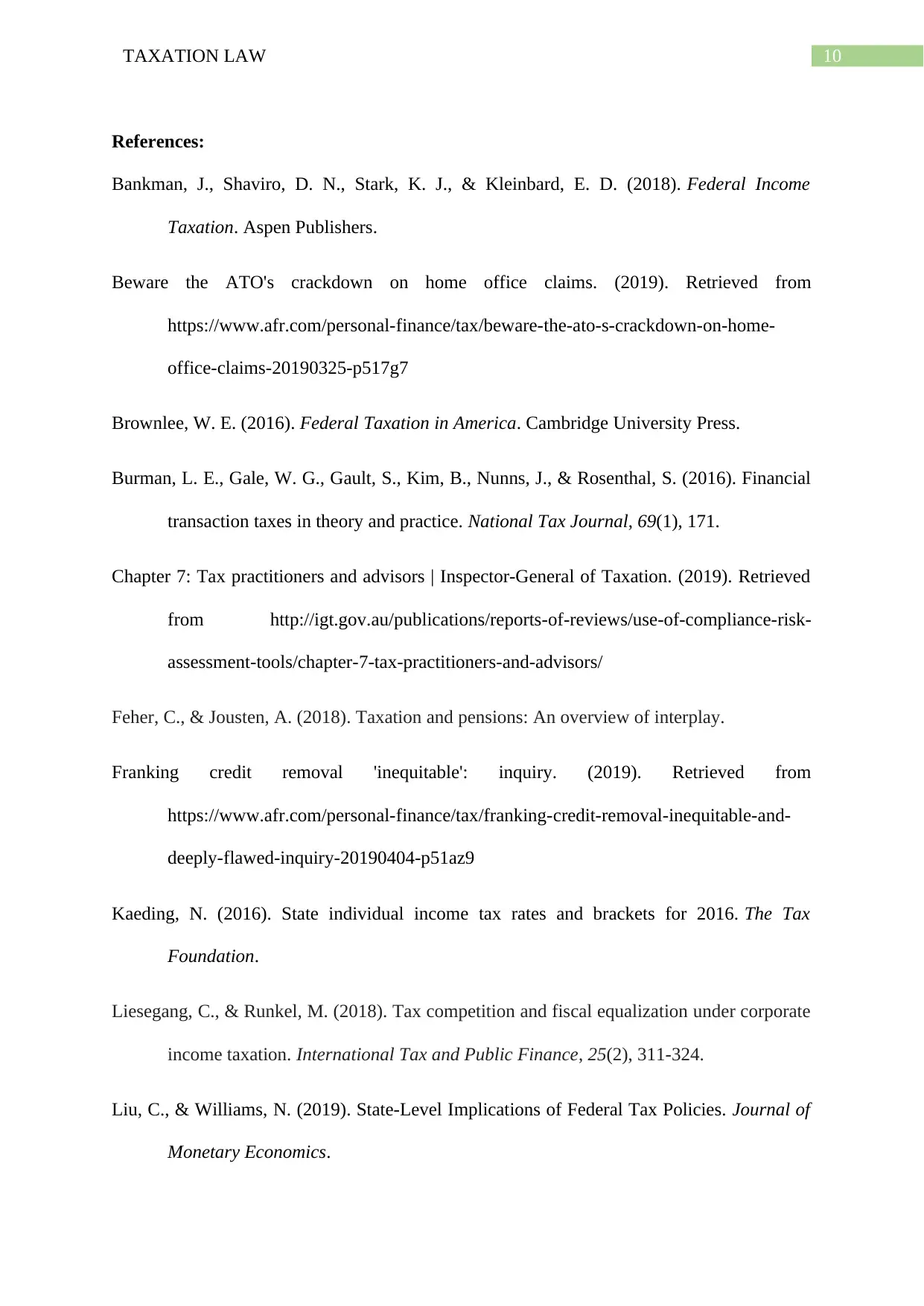
10TAXATION LAW
References:
Bankman, J., Shaviro, D. N., Stark, K. J., & Kleinbard, E. D. (2018). Federal Income
Taxation. Aspen Publishers.
Beware the ATO's crackdown on home office claims. (2019). Retrieved from
https://www.afr.com/personal-finance/tax/beware-the-ato-s-crackdown-on-home-
office-claims-20190325-p517g7
Brownlee, W. E. (2016). Federal Taxation in America. Cambridge University Press.
Burman, L. E., Gale, W. G., Gault, S., Kim, B., Nunns, J., & Rosenthal, S. (2016). Financial
transaction taxes in theory and practice. National Tax Journal, 69(1), 171.
Chapter 7: Tax practitioners and advisors | Inspector-General of Taxation. (2019). Retrieved
from http://igt.gov.au/publications/reports-of-reviews/use-of-compliance-risk-
assessment-tools/chapter-7-tax-practitioners-and-advisors/
Feher, C., & Jousten, A. (2018). Taxation and pensions: An overview of interplay.
Franking credit removal 'inequitable': inquiry. (2019). Retrieved from
https://www.afr.com/personal-finance/tax/franking-credit-removal-inequitable-and-
deeply-flawed-inquiry-20190404-p51az9
Kaeding, N. (2016). State individual income tax rates and brackets for 2016. The Tax
Foundation.
Liesegang, C., & Runkel, M. (2018). Tax competition and fiscal equalization under corporate
income taxation. International Tax and Public Finance, 25(2), 311-324.
Liu, C., & Williams, N. (2019). State-Level Implications of Federal Tax Policies. Journal of
Monetary Economics.
References:
Bankman, J., Shaviro, D. N., Stark, K. J., & Kleinbard, E. D. (2018). Federal Income
Taxation. Aspen Publishers.
Beware the ATO's crackdown on home office claims. (2019). Retrieved from
https://www.afr.com/personal-finance/tax/beware-the-ato-s-crackdown-on-home-
office-claims-20190325-p517g7
Brownlee, W. E. (2016). Federal Taxation in America. Cambridge University Press.
Burman, L. E., Gale, W. G., Gault, S., Kim, B., Nunns, J., & Rosenthal, S. (2016). Financial
transaction taxes in theory and practice. National Tax Journal, 69(1), 171.
Chapter 7: Tax practitioners and advisors | Inspector-General of Taxation. (2019). Retrieved
from http://igt.gov.au/publications/reports-of-reviews/use-of-compliance-risk-
assessment-tools/chapter-7-tax-practitioners-and-advisors/
Feher, C., & Jousten, A. (2018). Taxation and pensions: An overview of interplay.
Franking credit removal 'inequitable': inquiry. (2019). Retrieved from
https://www.afr.com/personal-finance/tax/franking-credit-removal-inequitable-and-
deeply-flawed-inquiry-20190404-p51az9
Kaeding, N. (2016). State individual income tax rates and brackets for 2016. The Tax
Foundation.
Liesegang, C., & Runkel, M. (2018). Tax competition and fiscal equalization under corporate
income taxation. International Tax and Public Finance, 25(2), 311-324.
Liu, C., & Williams, N. (2019). State-Level Implications of Federal Tax Policies. Journal of
Monetary Economics.
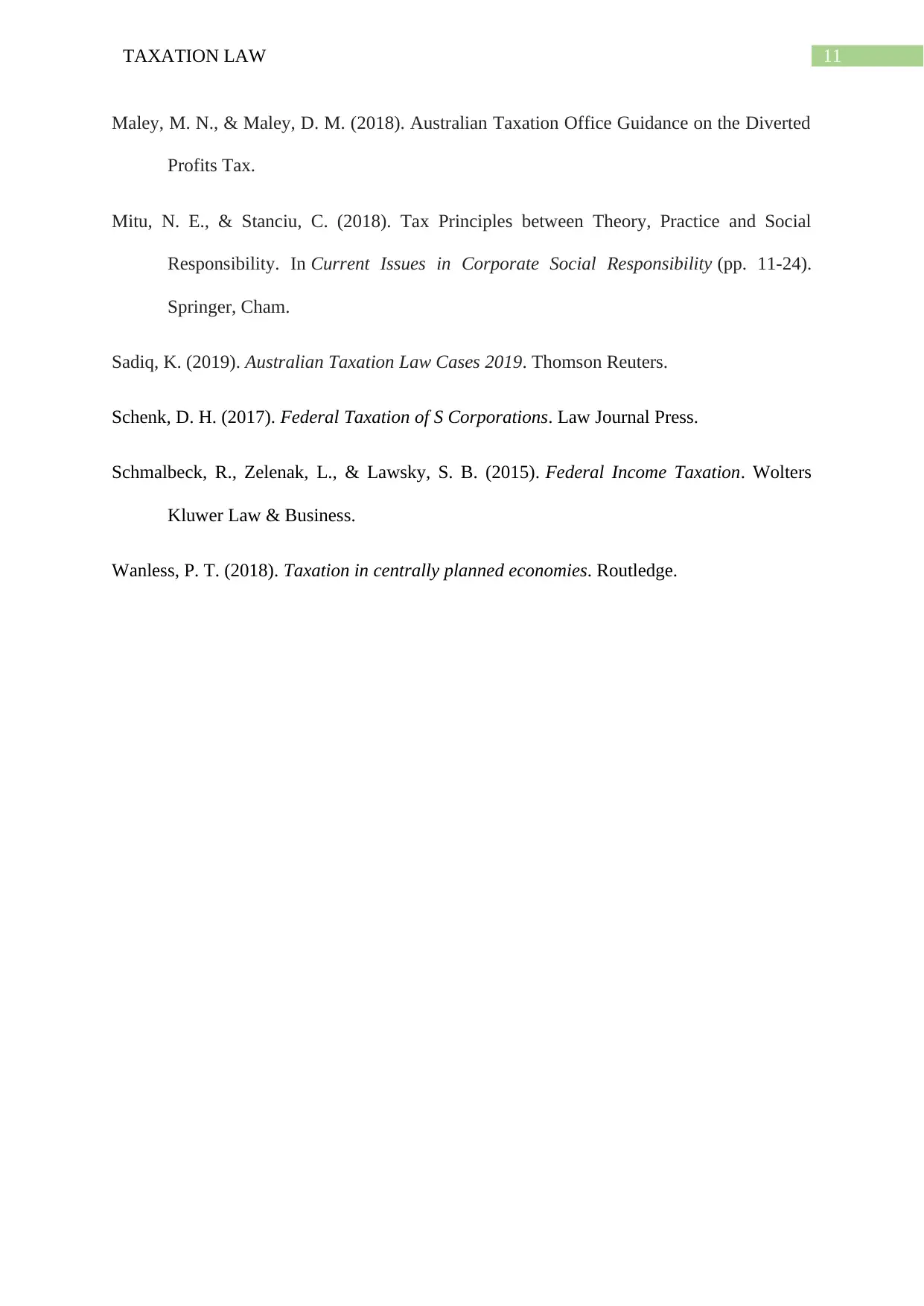
11TAXATION LAW
Maley, M. N., & Maley, D. M. (2018). Australian Taxation Office Guidance on the Diverted
Profits Tax.
Mitu, N. E., & Stanciu, C. (2018). Tax Principles between Theory, Practice and Social
Responsibility. In Current Issues in Corporate Social Responsibility (pp. 11-24).
Springer, Cham.
Sadiq, K. (2019). Australian Taxation Law Cases 2019. Thomson Reuters.
Schenk, D. H. (2017). Federal Taxation of S Corporations. Law Journal Press.
Schmalbeck, R., Zelenak, L., & Lawsky, S. B. (2015). Federal Income Taxation. Wolters
Kluwer Law & Business.
Wanless, P. T. (2018). Taxation in centrally planned economies. Routledge.
Maley, M. N., & Maley, D. M. (2018). Australian Taxation Office Guidance on the Diverted
Profits Tax.
Mitu, N. E., & Stanciu, C. (2018). Tax Principles between Theory, Practice and Social
Responsibility. In Current Issues in Corporate Social Responsibility (pp. 11-24).
Springer, Cham.
Sadiq, K. (2019). Australian Taxation Law Cases 2019. Thomson Reuters.
Schenk, D. H. (2017). Federal Taxation of S Corporations. Law Journal Press.
Schmalbeck, R., Zelenak, L., & Lawsky, S. B. (2015). Federal Income Taxation. Wolters
Kluwer Law & Business.
Wanless, P. T. (2018). Taxation in centrally planned economies. Routledge.
⊘ This is a preview!⊘
Do you want full access?
Subscribe today to unlock all pages.

Trusted by 1+ million students worldwide
1 out of 12
Related Documents
Your All-in-One AI-Powered Toolkit for Academic Success.
+13062052269
info@desklib.com
Available 24*7 on WhatsApp / Email
![[object Object]](/_next/static/media/star-bottom.7253800d.svg)
Unlock your academic potential
Copyright © 2020–2025 A2Z Services. All Rights Reserved. Developed and managed by ZUCOL.





